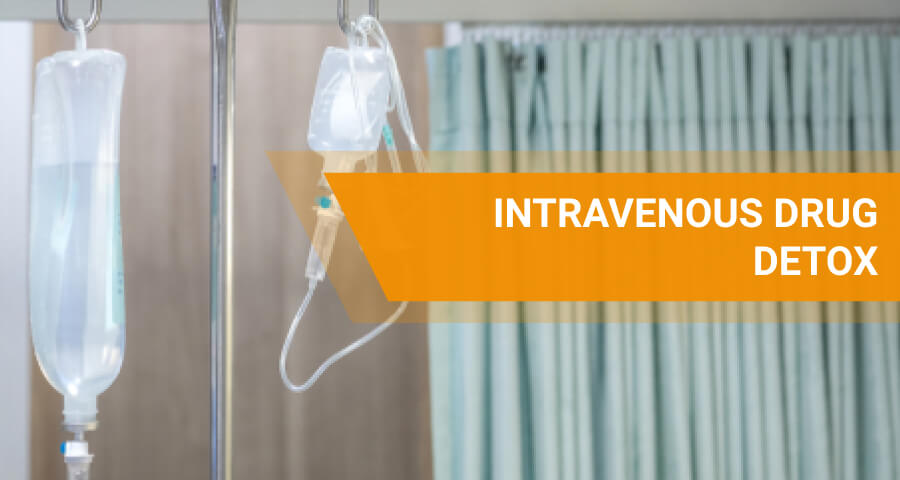
IV detox therapy is a medically supervised treatment that uses intravenous fluids, electrolytes, and vitamins to support people going through drug or alcohol withdrawal. Unlike wellness “detox drips” offered in spas, IV detox in addiction medicine is part of a structured medical detox program. It does not instantly flush out substances from the body. Instead, it stabilizes patients, reduces the severity of withdrawal symptoms, and lowers the risk of complications when overseen by trained professionals.
This article explains what IV detox involves, when it’s used, what to expect, how it helps (and what it can’t do), safety considerations, and practical FAQs so visitors can decide whether medically supervised IV support is appropriate.
Key points (quick takeaways)
- IV detox rehydrates, corrects electrolytes, and delivers critical vitamins — it does not “flush drugs out.” NIAAA
- IV therapy is commonly used in alcohol withdrawal to prevent complications (e.g., thiamine to reduce risk of serious neurological injury). PMC
- IV therapy supports but does not replace medication-assisted treatment (MAT) for opioid dependence. SAMHSA Library
- Severe alcohol withdrawal can be life-threatening — supervised medical detox is strongly recommended. NCBI
- Avoid “at-home” or wellness IVs for withdrawal — treatment should be done in licensed medical settings. NABP
What is IV Detox Therapy?
IV Detox Therapy is a medical treatment that uses intravenous (IV) fluids, vitamins, and medications to support people going through withdrawal from substances such as drugs, alcohol, or opiates. Unlike traditional detox, where nutrients and medications are taken orally, IV detox delivers them directly into the bloodstream.
It is often used alongside medical supervision, counseling, and long-term treatment programs to give patients the best chance of recovery.
Read More: What drug detox really involves
IV Detox Therapy for Drugs, Alcohol, and Opiates
IV Detox Therapy is often used as part of a broader treatment plan for people struggling with drug, alcohol, or opiate addiction. During withdrawal, the body is under stress, and natural detoxification may not be enough to manage symptoms safely. This is why IV detox therapy is often recommended, as it provides targeted support to stabilize the body, replenish essential nutrients, and prevent complications.
IV Detox Therapy For Drugs: Stimulant drugs such as cocaine or methamphetamine can cause severe dehydration, sleep problems, and nutrient depletion. IV detox helps restore electrolytes and energy levels, but it does not address cravings or long-term dependence.
Read more: Drug Detox
IV Detox Therapy For Alcohol: Alcohol withdrawal can lead to dangerous complications, including seizures and delirium tremens (DTs). IV detox therapy may provide fluids, vitamins like thiamine, and medications to stabilize symptoms, but it must always be done under medical supervision
IV Detox Therapy For Opiates: Withdrawal from opioids such as heroin, fentanyl, or prescription painkillers is highly uncomfortable and can include nausea, sweating, and muscle pain. IV detox therapy may ease some of these symptoms, but it cannot replace evidence-based treatments like methadone, buprenorphine, or naltrexone.
Important clinical point: IV therapy supports the body while the liver and kidneys metabolize and eliminate substances. IV fluids do not speed up hepatic alcohol metabolism or instantly “cleanse” the bloodstream.
How IV Detox Therapy Works
IV Detox Therapy works by delivering fluids, electrolytes, vitamins, and sometimes medications directly into the bloodstream through an intravenous (IV) line. This method allows the body to absorb nutrients more quickly than with oral supplements, which can be helpful during the physically demanding detox process. Here’s how it supports recovery from drugs, alcohol, and opiates:
Rehydration: Many substances cause dehydration. IV fluids quickly restore fluid balance, which may ease headaches, fatigue, and dizziness.
Nutrient Replenishment: Long-term substance use often depletes essential nutrients such as B vitamins, magnesium, and amino acids. IV therapy can help restore these levels faster than diet alone.
Symptom Management: Some clinics add medications to the IV drip (such as anti-nausea drugs or mild sedatives) to reduce withdrawal discomfort.
Energy and Cellular Repair: Therapies like NAD+ infusions are sometimes promoted for repairing cellular function, although research on their effectiveness for addiction treatment is still limited.
Why IV Detox Is Used in Addiction Treatment?
IV detox therapy is often part of a broader medical detox program. It helps patients stabilize and transition safely to further treatment:
- Eases withdrawal discomfort by addressing dehydration and nutrient deficiencies.
- Supports medication-assisted treatment (MAT): When used with medications such as benzodiazepines (for alcohol withdrawal) or buprenorphine/methadone (for opioid withdrawal), IV fluids help stabilize the body so the medications can work more effectively.
- Prevents complications: For example, thiamine supplementation through IV therapy reduces the risk of Wernicke’s encephalopathy and seizures in alcohol withdrawal.
- Promotes stabilization: Restoring physical balance helps patients transition into the next stages of addiction treatment, such as inpatient rehab or outpatient care.
Bottom line: IV detox therapy is a valuable supportive tool, but it is not a standalone cure for substance use disorder — it’s one component of medical detox and ongoing treatment planning.
Who is a Candidate for IV Detox Therapy?
IV therapy is generally recommended when withdrawal symptoms or health risks are too severe for home management, and it is considered when a patient shows one or more of the following:
- Moderate to severe withdrawal symptoms (e.g., persistent vomiting, inability to keep fluids down, pronounced tremor).
- Clinical risk factors for complications (history of prior severe withdrawal, seizures, liver disease, malnutrition).
- Need for rapid vitamin repletion (for example, patients with chronic, heavy alcohol use who require IV thiamine).
- Inpatient or monitored setting placement (IV support is standard when patients are hospitalized or in a licensed detox unit).
- Not every person who stops alcohol or drugs needs IV therapy — mild withdrawal may be managed with oral fluids and outpatient support when clinically appropriate.
Read more: At-home detox options
IV Detox Treatment and Administration Process
The process of IV detox therapy is usually carried out in a clinical or rehab setting under medical supervision. A healthcare professional inserts an IV line into a vein, typically in the arm, and delivers a customized mix of fluids, vitamins, electrolytes, and sometimes medications. What usually happens during IV detox therapy:
- Initial Assessment: A doctor or nurse evaluates the patient’s health, substance use history, and withdrawal symptoms to decide if IV therapy is appropriate.
- IV Line Placement: A sterile IV catheter is placed into the vein, and fluids are administered slowly over several hours.
- Customized Infusion: The IV “cocktail” may include:
- Saline solution for hydration
- Electrolytes such as sodium, potassium, or magnesium
- Vitamins like B-complex and vitamin C
- Medications (anti-nausea, anti-anxiety, or mild pain relievers) if prescribed
- Monitoring: Vital signs are checked during treatment to ensure safety and manage side effects.
- Follow-Up Care: IV detox is often repeated daily or several times a week depending on severity of withdrawal, but it’s typically combined with counseling or long-term addiction treatment.
Can You Speed Up Detox with IV Therapy?
A common misconception is that IV detox “speeds up” the body’s ability to clear drugs or alcohol. In reality, detoxification depends largely on liver and kidney function. IV therapy cannot override these natural processes.
What IV therapy can do is make the detox process safer and more tolerable by stabilizing the body, allowing medical staff to manage withdrawal symptoms more effectively. “Quick fix” IV drips marketed outside clinical settings often provide false reassurance and may expose individuals to risks if not medically supervised.
Benefits and Limitations of IV Detox for Drugs and Alcohol Addiction
IV detox therapy can be helpful during the early stages of withdrawal, but it is not a stand-alone cure for addiction. It is most effective when combined with comprehensive treatment programs such as counseling, behavioral therapy, and medication-assisted treatment.
Benefits:
Rapid Hydration: IV fluids quickly restore hydration, which can ease headaches, fatigue, and dizziness often seen during detox.
Nutrient Support: Substance use often depletes B vitamins, vitamin C, and minerals. IV therapy replenishes these nutrients faster than oral supplements.
Symptom Relief: Anti-nausea or anti-anxiety medications can sometimes be included in IV therapy to ease withdrawal symptoms.
Faster Absorption: Because nutrients bypass the digestive system, IV therapy allows for quicker uptake into the bloodstream.
Limitations:
Not a Cure for Drug Addiction: IV detox therapy does not stop cravings, treat the root causes of substance use, or prevent relapse.
Requires Medical Oversight: Alcohol and opioid withdrawals can be dangerous or life-threatening. IV detox should only be performed under medical supervision.
Temporary Relief: IV detox addresses symptoms during withdrawal but must be paired with longer-term addiction treatment for lasting recovery.
“Key Point: While IV detox therapy can make the detox stage more tolerable, it should not be viewed as a stand-alone cure. Addiction is a complex medical condition, and recovery requires a combination of medical treatment, behavioral therapy, and long-term support.”
Conclusion
IV detox therapy is a powerful tool for stabilizing patients during the early, high-risk phase of withdrawal. By replenishing fluids, correcting imbalances, and supporting the body through withdrawal, it paves the way for long-term recovery.
If you or someone you care about is struggling with substance use, remember that help is available. Explore our treatment guides and rehab directory to take the next step toward a healthier future.
Recovery starts with the first decision — and it can start today
People Also Ask
Is IV detox safe for everyone?
Not always. It should be administered in a medical setting, especially for those with severe withdrawal, chronic illness, or history of seizures.
How long does IV detox take?
Most IV sessions last 30–90 minutes, but the full detox timeline
varies depending on the drug, duration of use, and overall health.
Can you detox at home with IV therapy?
Home IV therapy is not recommended due to infection risk and lack of monitoring. At-home detox
should only be attempted under medical guidance.
Does IV therapy stop cravings?
No, IV therapy relieves physical symptoms but does not address cravings or psychological dependence. Ongoing treatment (counseling, MAT) is necessary.
Can an IV flush out alcohol?
No, alcohol is metabolized primarily by liver enzymes (alcohol dehydrogenase/aldehyde dehydrogenase). IV fluids support hydration and metabolism but do not accelerate liver clearance of alcohol or immediately remove it from blood. Time remains the main factor in elimination.
NIAAA
Which IV fluid is best for alcohol withdrawal?
Clinically, isotonic crystalloids such as normal saline (0.9% NaCl) or lactated Ringer’s are commonly used to correct volume depletion; these are frequently given together with thiamine (to prevent Wernicke’s encephalopathy) and other B vitamins/electrolytes as needed. Exact dosing and selection depend on assessment and labs.
Hope Without Commitment
Find the best treatment options. Call our free and confidential helpline
Most private insurances accepted
Find Drug Rehabilitation Centers Near You Anywhere In the US
Addiction Resource team has compiled an extensive list of the top drug rehabilitation facilities around the country. Use our locator tool to find the best centers near you.
Page Sources
- Nagy, N. E. S., et al. (2022). Assessment of addiction management program and predictors of relapse among inpatients of the Psychiatric Institute at Ain Shams University Hospital. Middle East Current Psychiatry, 29(1). https://doi.org/10.1186/s43045-022-00246-5
- Bahji, A., et al. (2022). Neurobiology and Symptomatology of Post-Acute Alcohol Withdrawal: A Mixed-Studies Systematic Review. Journal of Studies on Alcohol and Drugs, 83(4), 461–469. https://doi.org/10.15288/jsad.2022.83.461
- Howell, B. A., & Chauhan, A. (2010). Current and emerging detoxification therapies for critical care. Materials, 3(4), 2483–2505. https://doi.org/10.3390/ma3042483
- Mahboub, N., et al. (2020). Nutritional status and eating habits of people who use drugs and/or are undergoing treatment for recovery: a narrative review. Nutrition Reviews, 79(6), 627–635. https://doi.org/10.1093/nutrit/nuaa095
- Office of Dietary Supplements - Vitamin K. (n.d.). https://ods.od.nih.gov/factsheets/VitaminK-HealthProfessional/
- Braidy, N., Villalva, M. D., & Van Eeden, S. (2020). Sobriety and satiety: Is NAD+ the answer? Antioxidants, 9(5), 425. https://doi.org/10.3390/antiox9050425
- Badgaiyan, R. D., et al. Nicotinamide adenine dinucleotide (NAD+) and enkephalinase inhibition (IV1114589NAD) infusions significantly attenuate psychiatric burden sequalae in Substance use disorder (SUD) in fifty cases. Current Psychiatry Research and Review/Current Psychiatry Research and Reviews, 18(2), 125–143. https://doi.org/10.2174/2666082218666220527114427
- Miller, M., et al. (2012). Early intervention of intravenous KB220IV- Neuroadaptagen Amino-Acid therapy (NAAT)TM improves behavioral outcomes in a residential addiction treatment program: a pilot study. Journal of Psychoactive Drugs, 44(5), 398–409. https://doi.org/10.1080/02791072.2012.737727


 Reviewed by:
Reviewed by:  Written by:
Written by: 
 FindTreatment.gov
FindTreatment.gov